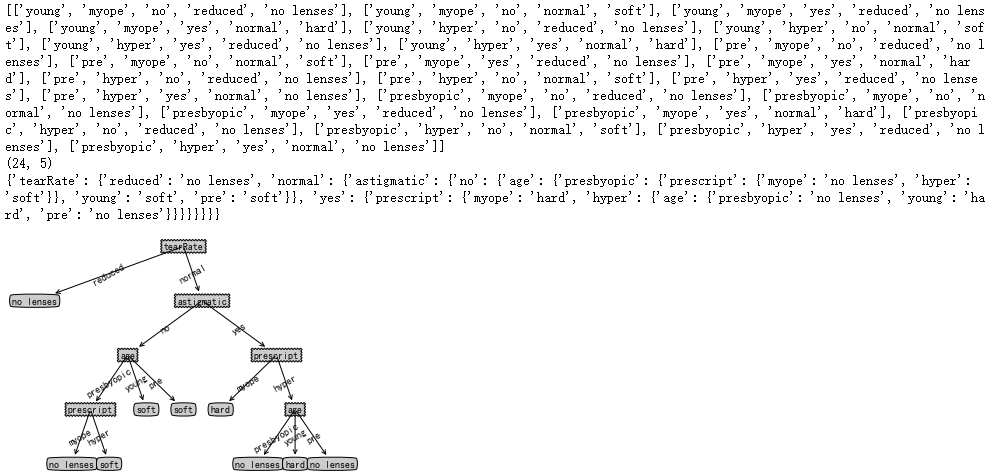吴裕雄--天生自然python机器学习:使用决策树预测隐形眼镜类型
解决策树如何预测患者需要佩戴的隐形眼镜类型。使用小数据
集,我们就可以利用决策树学到很多知识:眼科医生是如何判断患者需要佩戴的镜片类型;一旦
理解了决策树的工作原理,我们甚至也可以帮助人们判断需要佩戴的镜片类型。



隐 形 眼 镜 数 据 集 是 非 常 著 名 的 数 据 集 ,它 包 含 很 多 患 者 眼 部 状 况 的 观 察 条 件 以 及 医 生 推 荐 的
隐 形 眼 镜 类 型 。隐 形 眼 镜 类 型 包 括 硬 材 质 、软 材 质 以 及 不 适 合 佩 戴 隐 形 眼 镜 。数 据 来 源 于UCI 数 据
库。
import numpy as np
import operator as op
from math import log def calcShannonEnt(dataSet):
labelCounts = {}
for featVec in dataSet:
currentLabel = featVec[-1]
if(currentLabel not in labelCounts.keys()):
labelCounts[currentLabel] = 0
labelCounts[currentLabel] += 1
shannonEnt = 0.0
rowNum = len(dataSet)
for key in labelCounts:
prob = float(labelCounts[key])/rowNum
shannonEnt -= prob * log(prob,2)
return shannonEnt def splitDataSet(dataSet, axis, value):
retDataSet = []
for featVec in dataSet:
if(featVec[axis] == value):
reducedFeatVec = featVec[:axis]
reducedFeatVec.extend(featVec[axis+1:])
retDataSet.append(reducedFeatVec)
return retDataSet def chooseBestFeatureToSplit(dataSet):
numFeatures = np.shape(dataSet)[1]-1
baseEntropy = calcShannonEnt(dataSet)
bestInfoGain = 0.0
bestFeature = -1
for i in range(numFeatures):
featList = [example[i] for example in dataSet]
uniqueVals = set(featList)
newEntropy = 0.0
for value in uniqueVals:
subDataSet = splitDataSet(dataSet, i, value)
prob = len(subDataSet)/float(len(dataSet))
newEntropy += prob * calcShannonEnt(subDataSet)
infoGain = baseEntropy - newEntropy
if (infoGain > bestInfoGain):
bestInfoGain = infoGain
bestFeature = i
return bestFeature def majorityCnt(classList):
classCount={}
for vote in classList:
if(vote not in classCount.keys()):
classCount[vote] = 0
classCount[vote] += 1
sortedClassCount = sorted(classCount.items(), key=op.itemgetter(1), reverse=True)
return sortedClassCount[0][0] def createTree(dataSet,labels):
classList = [example[-1] for example in dataSet]
if(classList.count(classList[0]) == len(classList)):
return classList[0]
if len(dataSet[0]) == 1:
return majorityCnt(classList)
bestFeat = chooseBestFeatureToSplit(dataSet)
bestFeatLabel = labels[bestFeat]
myTree = {bestFeatLabel:{}}
del(labels[bestFeat])
featValues = [example[bestFeat] for example in dataSet]
uniqueVals = set(featValues)
for value in uniqueVals:
subLabels = labels[:]
myTree[bestFeatLabel][value] = createTree(splitDataSet(dataSet, bestFeat, value),subLabels)
return myTree def classify(inputTree,featLabels,testVec):
for i in inputTree.keys():
firstStr = i
break
secondDict = inputTree[firstStr]
featIndex = featLabels.index(firstStr)
key = testVec[featIndex]
valueOfFeat = secondDict[key]
if isinstance(valueOfFeat, dict):
classLabel = classify(valueOfFeat, featLabels, testVec)
else:
classLabel = valueOfFeat
return classLabel data = open("F:\\machinelearninginaction\\Ch03\\lenses.txt")
dataSet = [inst.strip().split("\t") for inst in data.readlines()]
print(dataSet)
print(np.shape(dataSet))
labels = ["age","prescript","astigmatic","tearRate"]
tree = createTree(dataSet,labels)
print(tree) import matplotlib.pyplot as plt decisionNode = dict(boxstyle="sawtooth", fc="0.8")
leafNode = dict(boxstyle="round4", fc="0.8")
arrow_args = dict(arrowstyle="<-") def getNumLeafs(myTree):
numLeafs = 0
for i in myTree.keys():
firstStr = i
break
secondDict = myTree[firstStr]
for key in secondDict.keys():
if type(secondDict[key]).__name__=='dict':
numLeafs += getNumLeafs(secondDict[key])
else: numLeafs +=1
return numLeafs def getTreeDepth(myTree):
maxDepth = 0
for i in myTree.keys():
firstStr = i
break
secondDict = myTree[firstStr]
for key in secondDict.keys():
if type(secondDict[key]).__name__=='dict':
thisDepth = 1 + getTreeDepth(secondDict[key])
else: thisDepth = 1
if thisDepth > maxDepth: maxDepth = thisDepth
return maxDepth def plotNode(nodeTxt, centerPt, parentPt, nodeType):
createPlot.ax1.annotate(nodeTxt, xy=parentPt, xycoords='axes fraction',xytext=centerPt, textcoords='axes fraction',va="center", ha="center", bbox=nodeType, arrowprops=arrow_args ) def plotMidText(cntrPt, parentPt, txtString):
xMid = (parentPt[0]-cntrPt[0])/2.0 + cntrPt[0]
yMid = (parentPt[1]-cntrPt[1])/2.0 + cntrPt[1]
createPlot.ax1.text(xMid, yMid, txtString, va="center", ha="center", rotation=30) def plotTree(myTree, parentPt, nodeTxt):
numLeafs = getNumLeafs(myTree)
depth = getTreeDepth(myTree)
for i in myTree.keys():
firstStr = i
break
cntrPt = (plotTree.xOff + (1.0 + float(numLeafs))/2.0/plotTree.totalW, plotTree.yOff)
plotMidText(cntrPt, parentPt, nodeTxt)
plotNode(firstStr, cntrPt, parentPt, decisionNode)
secondDict = myTree[firstStr]
plotTree.yOff = plotTree.yOff - 1.0/plotTree.totalD
for key in secondDict.keys():
if type(secondDict[key]).__name__=='dict':
plotTree(secondDict[key],cntrPt,str(key))
else:
plotTree.xOff = plotTree.xOff + 1.0/plotTree.totalW
plotNode(secondDict[key], (plotTree.xOff, plotTree.yOff), cntrPt, leafNode)
plotMidText((plotTree.xOff, plotTree.yOff), cntrPt, str(key))
plotTree.yOff = plotTree.yOff + 1.0/plotTree.totalD def createPlot(inTree):
fig = plt.figure(1, facecolor='white')
fig.clf()
axprops = dict(xticks=[], yticks=[])
createPlot.ax1 = plt.subplot(111, frameon=False, **axprops)
#createPlot.ax1 = plt.subplot(111, frameon=False) #ticks for demo puropses
plotTree.totalW = float(getNumLeafs(inTree))
plotTree.totalD = float(getTreeDepth(inTree))
plotTree.xOff = -0.5/plotTree.totalW; plotTree.yOff = 1.0;
plotTree(inTree, (0.5,1.0), '')
plt.show() createPlot(tree)

可 以 发 现 ,医 生 最 多 需 要 问 四 个 问 题 就 能 确 定 患 者 需 要 佩 戴 哪 种 类 型 的 隐 形 眼 镜 。
小结:

吴裕雄--天生自然python机器学习:使用决策树预测隐形眼镜类型的更多相关文章
- 吴裕雄--天生自然python机器学习:机器学习简介
除却一些无关紧要的情况,人们很难直接从原始数据本身获得所需信息.例如 ,对于垃圾邮 件的检测,侦测一个单词是否存在并没有太大的作用,然而当某几个特定单词同时出现时,再辅 以考察邮件长度及其他因素,人们 ...
- 吴裕雄--天生自然python机器学习实战:K-NN算法约会网站好友喜好预测以及手写数字预测分类实验
实验设备与软件环境 硬件环境:内存ddr3 4G及以上的x86架构主机一部 系统环境:windows 软件环境:Anaconda2(64位),python3.5,jupyter 内核版本:window ...
- 吴裕雄--天生自然python机器学习:决策树算法
我们经常使用决策树处理分类问题’近来的调查表明决策树也是最经常使用的数据挖掘算法. 它之所以如此流行,一个很重要的原因就是使用者基本上不用了解机器学习算法,也不用深究它 是如何工作的. K-近邻算法可 ...
- 吴裕雄--天生自然python机器学习:朴素贝叶斯算法
分类器有时会产生错误结果,这时可以要求分类器给出一个最优的类别猜测结果,同 时给出这个猜测的概率估计值. 概率论是许多机器学习算法的基础 在计算 特征值取某个值的概率时涉及了一些概率知识,在那里我们先 ...
- 吴裕雄--天生自然python机器学习:支持向量机SVM
基于最大间隔分隔数据 import matplotlib import matplotlib.pyplot as plt from numpy import * xcord0 = [] ycord0 ...
- 吴裕雄--天生自然python机器学习:使用K-近邻算法改进约会网站的配对效果
在约会网站使用K-近邻算法 准备数据:从文本文件中解析数据 海伦收集约会数据巳经有了一段时间,她把这些数据存放在文本文件(1如1^及抓 比加 中,每 个样本数据占据一行,总共有1000行.海伦的样本主 ...
- 吴裕雄--天生自然python机器学习:基于支持向量机SVM的手写数字识别
from numpy import * def img2vector(filename): returnVect = zeros((1,1024)) fr = open(filename) for i ...
- 吴裕雄--天生自然python机器学习:使用Logistic回归从疝气病症预测病马的死亡率
,除了部分指标主观和难以测量外,该数据还存在一个问题,数据集中有 30%的值是缺失的.下面将首先介绍如何处理数据集中的数据缺失问题,然 后 再 利 用 Logistic回 归 和随机梯度上升算法来预测 ...
- 吴裕雄--天生自然python机器学习:Logistic回归
假设现在有一些数据点,我们用 一条直线对这些点进行拟合(该线称为最佳拟合直线),这个拟合过程就称作回归.利用Logistic回归进行分类的主要思想是:根据现有数据对分类边界线建立回归公式,以此进行分类 ...
随机推荐
- Day 12:枚举值、枚举类
jdk1.5新特性之-----枚举 问题:某些方法所接收的数据必须是在固定范围之内的, 解决方案: 这时候我们的解决方案就是自定义一个类,然后是私有化构造函数,在自定义类中创建本类的对象对外使用. ...
- Linux学习打卡20200214
- ORACLE常见问题收集
1.Java代码执行oracle,update和insert语句卡住不动 解决方法:造成这样的情况原因在于你之前执行了update或insert操作但你并没有commit,导致你操作的这条记录被ora ...
- 记Windows下初次使用dev C++进行socket编程过程
记初次接触socket编程,在devC++使用Winsock进行socket编程的一个过程,通过在devC++创建2个项目分别是server.client程序项目,感受通过socket使client与 ...
- Python连接Oracle问题
Python连接Oracle问题 1.pip install cx_oracle 2.会出现乱码问题: 方法一:配置环境变量 export NLS_LANG="SIMPLIF ...
- Java 类提供了自定义的构造方法,那么类的默认构造不会被调用
以下代码无法通过编译: public class Test1 { public static void main(String[] args) { //int a=6; Foo obj=new Foo ...
- ZOJ 3757 Alice and Bod 模拟
上次的ZJU月赛题,规则比较复杂,当时就连题意都没摸清楚,只觉得非常复杂 比完后敲啊敲啊敲,连续WA啊,该反思下自己,没按照题意来设置条件,题目中说了 白球入袋并且... 给对手加分 ,白球未入袋并且 ...
- 4. git目录探秘
HEAD当前指向的分支信息.cconfig,当前仓库的配置信息,core,用户,远程,分支等信息.(命令操作其实就是修改当前config文件)refs---heads,其实就是分支,里面包含所有的分支 ...
- springMVC源码阅读-通过画图理解一个请求生命周期(十二)
- PAT Advanced 1115 Counting Nodes in a BST (30) [⼆叉树的遍历,BFS,DFS]
题目 A Binary Search Tree (BST) is recursively defined as a binary tree which has the following proper ...
